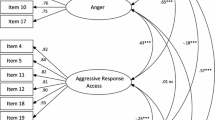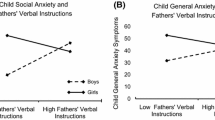Abstract
Parent-child interactions of aggressive and depressed/anxious clinic-referred children were observed during two different tasks: planning a vacation and discussing a conflict. Marked group differences were found as a function of the type of task, who was speaking (parent vs. child), and type of child psychopathology. Negative behaviors (e.g., Belittling and Blaming) were especially pronounced in the conflict task, whereas positive behaviors (e.g., Nurturing and Protecting) were more common in the planning task. Parents displayed other-directed behavior (e.g., Watching and Controlling), whereas children showed more self-directed behavior (e.g., Walling Off and Distancing), and patterns of child psychopathology interacted with task and speaker in theoretically important ways; for example, parents of aggressive children showed more Belittling and Blaming than their children in the conflict task, but not in the planning task. The findings highlight key factors that may need to be incorporated into models of parent-child interaction and child psychopathology.
Similar content being viewed by others
REFERENCES
American Psychiatric Association. (1987). Diagnostic and statistical manual of mental disorders (3rd ed., rev.). Washington, DC: Author.
Achenbach, T. (1991). Manual for the Child Behavior Checklist/4–18 and 1991 Profile. Burlington: University of Vermont, Department of Psychiatry.
Achenbach, T., & Edelbrock, C. (1986). Manual for the Teacher's Report Form and Teacher Version of the Child Behavior Profile. Burlington: University of Vermont, Department of Psychiatry.
Achenbach, T., & Edelbrock, C. (1987). Manual for the Youth Self-Report and Profile. Burlington: University of Vermont, Department of Psychiatry.
Achenbach, T., McCbnaughy, S., & Howell, C. (1987). Child/adolescent behavioral and emotional problems: Implications of cross-informant correlations for siruationai specificity. Psychological Bulletin, 101, 213–232.
Alexander, J., Waldron, H., Barton, C, & Mas, C. (1989). The minimizing of blaming attributions and behaviors in delinquent families. Journal of Consulting and Clinical Psychology, 57, 19–24.
Bell, R. (1968). A reinterpretation of the direction of effects in studies of socialization. Psychological Review, 75, 81–95.
Benjamin, L. (1974). Structural analysis of social behavior (SASB). Psychological Review, 81, 392–425.
Bernstein, G., Svingen, P., & Garfinkel, B. (1990). School phobia: Patterns of family functioning. Journal of the American Academy of Child and Adolescent Psychiatry, 29, 24–30.
Borduin, C., Pruitt, J., & Henggeler, S. (1985). Family interactions in black, lower-class families with delinquent and nondelinquent adolescent boys. The Journal of Genetic Psychology, 147, 333–342.
Bronfenbrenner, U. (1986). Ecology of the family as a context for human development: Research perspectives. Developmental Psychology, 22, 723–742.
Burbach, D., & Borduin, C. (1986). Parent-child relations and the etiology of depression: A review of methods and findings. Clinical Psychology Review, 6, 133–153.
Camilli, G., & Hopkins, K. (1979). Testing for association in 2*2 contingency tables with very small sample sizes. Psychological Bulletin, 86, 1011–1014.
Christensen, A., & Margolin, G. (1988). Conflict and alliance in distressed and nondistressed families. In R. Hinde & J. Stevenson-Hinde (Eds.), Relationships within families: Mutual influences (pp. 263–282). Oxford, England: Oxford University Press.
Cole, D., & Rchm, L. (1986). Family interaction patterns and childhood depression. Journal of Abnormal Child Psychology, 14, 297–314.
Costello, A., Edelbrock, C., Dulcan, M., Kalas, R., & Klaric, S. (1984). Development and testing of the NIMH diagnostic interview schedule for children in a clinic population: Final report (Contract RFP-DB081-0027). Rockville MD: Center for Epidemiologic Studies, NIMH.
Dadds, M., & Sanders, M. (1992). Family interaction and child psychopathology: A comparison of two observation strategies. Journal of Child and Family Studies, 1, 371–391.
Epstein, S., & O'Brien, E. (1985). The person-situation debate in historical and current perspective. Psychological Bulletin, 98, 513–537.
Gilbert, R., Christensen, A., & Margolin, G. (1984). Patterns of alliances in nondistressed and multiproblem families. Family Process, 23, 75–87.
Gjerde, P. (1986). The interpersonal structure of family interaction settings: Parent-adolescent relations in dyads and triads. Developmental Psychology, 22, 297–304.
Gordon, D., Burge, D., Hammen, C., Adrian, C., Jaenicke, C., & Hiroto, D. (1989). Observations of interactions of depressed women with their children. American Journal of Psychiatry, 146, 50–55.
Gould, M., Bird, H., & Staghezza, B. (1993). Correspondence between statistically derived behavior problem syndromes and child psychiatric diagnoses in a community sample. Journal of Abnormal Child Psychology, 21, 287–313.
Hayes, W. (1973). Statistics for the social sciences. (2nd ed.). New York: Holt, Rinehart, and Winston.
Henggeler, S., & Borduin, C. (1990). Family therapy and beyond: A multisystemic approach to treating the behavior problems of children and adolescents. Pacific Grove, CA: Brooks/Cole.
Henggeler, S., Borduin, C., Rodick, J. D., & Tavormina, J. (1979). Importance of task content for family interaction research. Developmental Psychology, 15, 660–661.
Henggeler, S., Edwards, J., & Borduin, C. (1987). The family relations of female juvenile delinquents. Journal of Abnormal Child Psychology, 15, 199–209.
Hetherington, E., & Martin, B. (1986). Family factors and psychopathology in children. In H. Quay & J. Werry (Eds.), Psychopathological disorders of childhood (3rd ed., pp. 332–390). New York: Wiley.
Huffington, C., & Sevitt, M. (1989). Family interaction in adolescent school phobia. Journal of Family Therapy, 11, 353–375.
Humes, D., & Humphrey, L. (1994). A multimethod analysis of families with a polydrug-dependent or normal adolescent daughter. Journal of Abnormal Psychology, 103, 676–685.
Humphrey, L. (1987). Comparisons of bulimic-anorexic and non-distressed families using Structural Analysis of Social Behavior. American Academy of Child and Adolescent Psychiatry, 26, 248–255.
Humphrey, L. (1989). Observed family interactions among subtypes of eating disorders using Structural Analysis of Social Behavior. Journal of Consulting and Clinical Psychology, 57, 206–214.
Humphrey, L., Apple, R., & Kirschenbaum, D. (1986). Differentiating bulimic-anorexic from normal families using an interpersonal and a behavioral observation system. Journal of Consulting and Clinical Psychology, 54, 190–195.
Humphrey, L., & Benjamin, L. (1989). An observational coding system for use with Structural Analysis of Social Behavior: The training manual Chicago, IL: Northwestern University Medical School.
Jacob, T., & Davis, J. (1973). Family interaction as a function of experimental task. Family Process, 12, 415–427.
Jacob, T., Tennenbaum, D., & Krahn, G. (1987). Factors influencing the reliability and validity of observation data. In T. Jacob (Ed.), Family interaction and psychopathology (pp. 297–328). New York: Plenum Press.
Jensen, P., Salzerg, A., Richters, J., & Watanabe, H. (1993). Scales, diagnoses, and child psychopathology: I. CBCL and DISC relationships. Journal of the American Academy of Child and Adolescent Psychiatry, 32, 397–406.
Johnson, S., & Bolstad, O. (1973). Methodological issues in naturalistic observation: Some problems and solutions for field research. In L. A. Hamerlynck, L. C Handy, & E. J. Mash (Eds.), Behavior change: Methodology, concepts, and practice. Champaign IL: Research Press.
Keitner, G., & Miller, I. (1990). Family functioning and major depression: An overview. American Journal of Psychiatry, 147, 1128–1137.
Leary, T. (1957). Interpersonal diagnosis of personality. New York: Ronald Press.
Lewinsohn, P., Roberts, R., Seeley, J., Rohde, P., Gotlib, I., & Hops, H. (1994). Adolescent psychopathology: II. Psychosocial risk factors for depression. Journal of Abnormal Psychology, 103, 302–315.
Loeber, R. (1990). Development and risk factors of juvenile antisocial behavior and delinquency. Clinical Psychology Review, 10, 1–41.
Marshall, V., Longwell, L., Goldstein, M., & Swanson, J. (1990). Family factors associated with aggressive symptomatology in boys with attention deficit hyperactivity disorder: A research note. Journal of Child Psychology and Psychiatry, 31, 629–636.
McColloch, M., Gilbert, D., & Johnson, S. (1990). Effects of situational variables on the interpersonal behavior of families with an aggressive adolescent. Personality and Individual Differences, 11, 1–11.
McCranie, E., & Bass, J. (1984). Childhood family antecedents of dependency and self-criticism: Implications for depression. Journal of Abnormal Psychology, 93, 3–8.
Messer, S., & Gross, A. (1995). Childhood depression and family interaction: A naturalistic observation study. Journal of Clinical Child Psychology, 24, 77–88.
Minuchin, S., Rosman, B., & Baker, L. (1978). Psychosomatic families. Cambridge MA: Harvard University Press.
Mischel, W. (1968). Personality and assessment. New York: Wiley.
Ollendick, T., & Yule, W. (1990). Depression in British and American children and its relation to anxiety and fear. Journal of Consulting and Clinical Psychology, 58, 126–129.
Paikoff, R., & Brooks-Gunn, J. (1991). Do parent-child relationships change during puberty? Psychological Bulletin, 110, 47–66.
Patterson, G. (1982). A social learning approach to family intervention: Vol 3. Coercive family process. Eugene, OR: Castalia.
Piacentini, J., Shaffer, D., Fisher, P., Schwab-Stone, M., Davies, M., & Gioia, P. (1993). The Diagnostic Interview Schedule for Children — Revised Version (DISC-R): III. Concurrent criterion validity. Journal of the American Academy of Child and Adolescent Psychiatry, 32, 658–665.
Roscoe, J., & Byars, J. (1971). An investigation of the restraints with respect to sample size commonly imposed on the use of the chi-square statistic. Journal of the American Statistical Association, 66, 755–759.
Sanders, M, Dadds, M., Johnston, B., & Cash, R. (1992). Childhood depression and conduct disorder: I. Behavioral, affective, and cognitive aspects of family problem-solving interactions. Journal of Abnormal Psychology, 101, 495–504.
Schaefer, E. (1965). A configurational analysis of children's reports of parent behavior. Journal of Consulting Psychology, 29, 552–557.
Shaffer, D., Fisher, P., Piacentini, J., Schwab-Stone, M., & Wicks, J. (1991). Diagnostic Interview Schedule for Children (DISC 2.3)—Parent Version. New York: Columbia University.
Shaffer, D., Schwab-Stone, M., Fisher, P., Cohen, P., Piacentini, J., Davies, M., Conners, C, & Regier, D. (1993). The Diagnostic Interview Schedule for Children — Revised Version (DISC-R): I. Preparation, field testing, interrater reliability, and acceptability. Journal of the American Academy of Child and Adolescent Psychiatry, 32, 643–650.
Shaw, D., & Bell, R. (1993). Developmental theories of parental contributors to antisocial behavior. Journal of Abnormal Child Psychology, 21, 493–518.
Shrout, P., & Fleiss, J. (1979). Intraclass correlations: Uses in assessing rater reliability. Psychological Bulletin, 86, 420–428.
Sillars, A. (1991). Behavioral observation. In B. Montgomery & S. Duck (Eds.), Studying interpersonal interaction (pp. 197–218). New York: Guilford Press.
Smetana, J., Yau, J., & Hanson, S. (1991). Conflict resolution in families of adolescents. Journal of Research on Adolescence, 1, 189–206.
Stark, K., Humphrey, L., Crook, K., & Lewis, K. (1990). Perceived family environments of depressed and anxious children: Child's and maternal figure's perspectives. Journal of Abnormal Child Psychology, 18, 527–547.
Steinberg, L. (1987). Impact of puberty on family relations: Effects of pubertal status and pubertal timing. Developmental Psychology, 23, 451–460.
Stice, E., Barrera, M., & Chassin, L. (1993). Relation of parental support and control to adolescents' externalizing symptomatology and substance use: A longitudinal examination of curvilinear effects. Journal of Abnormal Child Psychology, 21, 609–629.
Stiles, W., & White, M. L. (1981). Parent-child interaction in the laboratory: Effects of role, task, and child behavior pathology on verbal response mode use. Journal of Abnormal Child Psychology, 9, 229–241.
Strauss, C., Last, C., Hersen, M., & Kazdin, A. (1988). Association between anxiety and depression in children and adolescents with anxiety disorders. Journal of Abnormal Child Psychology, 16, 57–68.
Sullivan, H. (1953). The interpersonal theory of psychiatry. New York: W. Norton.
Teaman, B., & Telch, M. (1988). Etiology of agoraphobia: An investigation of perceived childhood and parental factors. Phobia Practice & Research Journal, 1, 13–24.
Weiss, B., & Weisz, J. (1988). Factor structure of self-reported depression: Clinic-referred children versus adolescents. Journal of Abnormal Psychology, 97, 492–495.
Zuckerman, E., & Jacob, T. (1979). Task effects in family interaction. Family Process, 18, 47–53.
Author information
Authors and Affiliations
Rights and permissions
About this article
Cite this article
Donenberg, G.R., Weisz, J.R. Experimental Task and Speaker Effects on Parent-Child Interactions of Aggressive and Depressed/Anxious Children. J Abnorm Child Psychol 25, 367–387 (1997). https://doi.org/10.1023/A:1025733023979
Issue Date:
DOI: https://doi.org/10.1023/A:1025733023979




